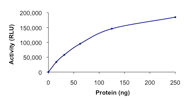
HDAC3, Active(H85-30G)
FOR BULK ORDER REQUESTS PLEASE CONTACT US
Description :Full-length recombinant human HDAC3 was expressed by baculovirus in Sf9 insect cells using a C-terminal GST tag.
Species :Human
Tag :GST tag
Expression System:Sf9 insect cells using baculovirus
Sequence :Full Length
Genbank Number :NM_003883
Specific Activity :Sample Histone Deacetylase Activity Plot. For specific information on a given lot, see related technical data sheet.
Purity :Sample Purity Data. For specific information on a given lot, see related technical data sheet.
Storage, Stability and Shipping :Store product at –70oC. For optimal storage, aliquot target into smaller quantities after centrifugation and store at recommended temperature. For most favorable performance, avoid repeated handling and multiple freeze/thaw cycles.
Applications :HDAC Assay, Western Blot
Molecular Weight :~83 kDa
Gene Aliases :HD3; RPD3; RPD3-2
Scientific Background :HDAC3 or Histone deacetylase 3 belongs to the histone deacetylase/acuc/apha family and is a component of the histone deacetylase complex that represses transcription when tethered to a promoter. HDAC3 may participate in the regulation of transcription through its binding with the zinc-finger transcription factor YY1. HDAC3 can also down-regulate p53 function and thus modulate cell growth and apoptosis. Catalytic domain of HDAC4 can interact with HDAC3 via the transcriptional corepressor NCOR2 (1). RELA is a nonhistone substrate of HDAC3 and IKBA-dependent nuclear export of the HDAC3-deacetylated RELA replenishes the depleted cytoplasmic pool of latent NFKB-IKBA complexes (2).
References :
1. Chen, L. et. al: Duration of nuclear NF-kappa-B action regulated by reversible acetylation. Science 293: 1653-1657, 2001.
2. Fischle, W. et al: Enzymatic activity associated with class II HDACs is dependent on a multiprotein complex containing HDAC3 and SMRT/N-CoR. Molec. Cell 9: 45-57, 2002.
Product Sheets (By Lot #) :
